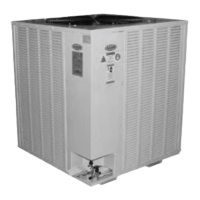Charging Refrigerant & Adjusting
Refrigerant Charge
The unit comes with full charge based on a
25 foot line set. Charging a system in the
field must be based on determination of
liquid sub-cooling and evaporator superheat.
On a system with a TXV, liquid sub-cooling
is more representative of the charge than
evaporator superheat but both measurements
must be taken.
Before Charging
Refer to the Unit Nameplate to determine
which refrigerant must be used to charge the
system.
Unit being charged must be at or near full
load conditions before adjusting the charge.
Units equipped with hot gas bypass must
have the hot gas bypass valve closed to get
the proper charge.
Units equipped with hot gas reheat must be
charged with the hot gas valves closed while
the unit is in cooling mode. After charging,
unit should be operated in reheat
(dehumidification) mode to check for
correct operation.
Units equipped with heat pump options
should be charged in heating mode to get the
proper charge. After charging, unit should
be operated in cooling mode to check for
correct charge. Charge may need to be
adjusted for cooling mode. If adjustments
are made in the cooling mode, heating mode
must be rerun to verify proper operation.
After adding or removing charge the system
must be allowed to stabilize, typically 10-15
minutes, before making any other
adjustments.
The type of unit and options determine the
ranges for liquid sub-cooling and evaporator
superheat. Refer to the table of acceptable
refrigerant circuit values when determining
the proper sub-cooling.
Checking Liquid Sub-cooling
Measure the temperature of the liquid line as
it leaves the condenser coil.
Read the gauge pressure reading of the
liquid line close to the point where the
temperature was taken. You must use liquid
line pressure as it will vary from discharge
pressure due to condenser coil pressure
drop.
Convert the pressure obtained to a saturated
temperature using the appropriate refrigerant
temperature-pressure chart or Table 5 below.
CLEAN AIR ACT
The Clean Air Act of 1990 bans the
intentional venting of refrigerant
(CFC’s and HCFC’s) as of July 1,
1992. Approved methods of recovery,
recycling or reclaiming must be
followed. Fines and/or incarceration
may be levied for non-compliance.
COMPRESSOR LUBRICANT
Polyolester (POE) and Polyvinylether
(PVE) oils are two types of lubricants
used in hydrofluorocarbon (HFC)
refrigeration systems. Refer to the
compressor label for the proper
compressor lubricant type.

